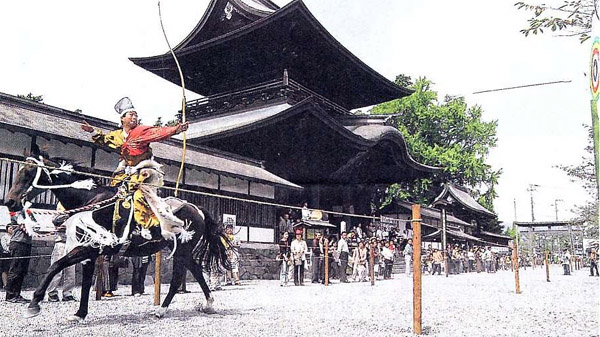Earthquake update: The main gate and hall of worship of Aso Shrine sadly collapsed in the Kumamoto earthquake of April 16th 2016. However, the shrine can still be visited and festivals will still be held throughout the year. In fact witnessing the damage first hand is a very humbling experience. The shrine will be rebuilt but the cost will be high, over 20 billion yen (12 million pounds) the majority of the cost will have to be met by the shrine itself so fundraising is vital. The rebuilding process is expected to take at least 10 years. Now more than ever the shrine and the whole Aso area needs international support. If you would like to make a donation from overseas please click here.
Don’t leave the Aso region without paying a visit to one of the oldest shrines in the country. The sombre and elegant Aso shrine 阿蘇神社 dates back to 281 AD or before the time of Japan’s first emperor. One of the oldest, most prominent shrines in Japan it is still very much a working shrine holding a variety of rites and festivals throughout the year. These rituals such as the Hifuri-Shinji and Onda Matsuri have been granted important cultural heritage status in Japan.
Explore Kumamoto can add a trip to Aso Shrine as part of your custom made Around Aso tour, just contact us with your request.
Twelve different deities are worshipped at the shrine these days however, originally the shrine is said to have been created to worship the Kami residing within the crater pond of Aso’s active peak Nakadake. this Kami and the Kami which created the land of Aso both over time came to be called by the same name of Takeiwatatsu 健磐龍命.
Takeiwatatsu 健磐龍命 the most important of Aso Shrine’s deities, is the grandson of the first Emperor Jimmu and has a direct lineage to the sun god Amaterasu. Many myths are told about Takeiwatatsu; he is said to have drained the vast caldera lake by kicking down part of the outer rim of the caldera. He was also responsible for teaching the local people how to cultivate Aso’s land, which is why many of the shrine rituals are related to agriculture. Takeiwatatsu is also worshipped as the guardian deity of navigation and nowadays is popular as a god protecting worshippers from traffic accidents, and, somewhat randomly, also exorcism, marriage, and learning. (Lucky charms for all these are on sale in the shrine shop.)
Visually speaking Aso Shrine is subdued in colour and design, the main impression being made by its beautiful swooping copper roof. However, in terms of architecture the two-storey main gate has been named as one of the three greatest grand shrine gates in Japan. (The other two being Hakozaki gu in Fukuoka and Kashima shrine in Ibaraki.) As you pass through the great gate, on your left you will see Takeiwatatsu’s great sword decorated with a white dragon. Signifying that the dragon of the incarnation of Takeiwatatsu severs misfortune.
Very unusually the approach and Tori gates for Aso Shrine extend sideways, rather than leading straight up to the main gate. The reason being that the approach continues in a straight line all the way to the sacred crater of Nakadake, welcoming the deity that resides there. This sideways approach is put to good use in the Yabusame festival in September and the Hifuri ritual in March.
[codepeople-post-map]
The sanctuary is located in Ge-gu (shrine at the lowest location), and Jo-gu (shrine at the highest or innermost location) in the crater of Aso-zan. It is believed that the shrine was built in 281 before the accession of the Emperor Jinmu, and it is one of the oldest and most prominent shrines in Japan. The deity enshrined is Tateiwatatsu-no-Mikoto, the grandson of Japans first emperor, Jinmu, who was said to have developed the Aso area. He



